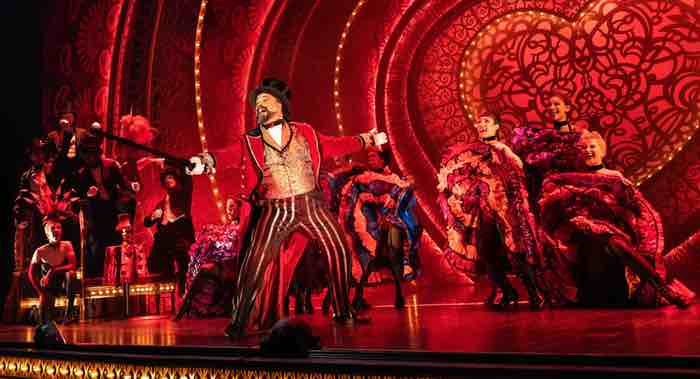
A jukebox musical is a stage show in which a majority of the songs were well known before they were inserted into plot, rather than being original music penned specifically for that show. Mamma Mia!, Jersey Boys, Rock of Ages, Tina and Jagged Little Pill are examples of shows of this genre. Overlapping the Golden Age of the American musical, starting in about 1943 with Oklahoma and the 1999 opening of Rent, the era of the musical drama, the jukebox musical has become a major Broadway theatrical commodity.
Jukebox musicals often have overblown sets and costumes, big musical sounds, lots of dynamic dancing and are bigger than life. These elements often overshadow the light storyline. They tend to use theatrical devices to get the audience on its feet during the closing number or by including a recap of high-energy songs from the show in the curtain call. The intention is to get the audience to exit the theater overjoyed by the dynamism of the production, carrying that energy in their minds as to the “wow” of the show.
A perfect example of the jukebox musical is Moulin Rouge! The Musical, now onstage at Playhouse Square’s Key Bank State Theatre. As pre-publicity states, “Enter a world of splendor and romance, of eye-popping excess, of glitz, grandeur and glory! A world where Bohemians and aristocrats rub elbows and revel in electrifying enchantment. Pop the champagne and prepare for the spectacular… Welcome to Moulin Rouge! The Musical.”
With a book by John Logan, it is based on the 2001 film Moulin Rouge!, which was directed by Baz Luhrmann and written by Luhrmann and Craig Pearce. The musical opened on Broadway on July 25, 2019. Like the film, it weaves together original and popular songs, including some written since the film’s premiere. As with all of Broadway, the show closed during the COVID epidemic. It reopened, and is still running on the Great White Way. At the 74th Tony Awards, Moulin Rouge! The Musical received a total of 14 nominations and won 10 awards (the most for the evening), including Best Musical.
The melodramatic sitcom story line relates how in 1899, Christian arrives in the Montmartre district of Paris from Ohio, where he meets bohemians Toulouse-Lautrec and Santiago, who are attempting to create a play with songs in it. The two are impressed by Christian’s musical and songwriting talents and ask for help to get their work produced at the Moulin Rouge. The trio celebrates the Bohemian ideals of truth, beauty, freedom and love.”
The duo takes Christian to the Moulin Rouge. At the same time, the money-motivated Duke of Monroth appears. Both Christian and the Duke both instantly “fall in love” with Satine. Christian’s, of course, is true love, while the Duke desires Satine as another beautiful possession. From here the “you know how this is going to turn out tale” follows a course of constant rivalry for the love of Satine.
A series of melodramatic turn of events throws roadblocks into the love tale, when not only does Satine contract consumption, but the Moulin’s financial future is in doubt, and the question of whether Bohemian Rhapsody, Christian’s musical, will be a success.
The tale wraps up when “Christian decides that without Satine’s love, he will load a prop gun with real bullets and commit suicide onstage during the play’s opening night. Meanwhile, Satine and Toulouse stand up to the Duke, who leaves the Moulin Rouge before the performance. As Satine performs, Christian enters and asks her to face him as he turns the gun his way. Before he pulls the trigger, Satine sings their secret song, saving his life and revealing to him that she loved him the entire time. After a final song together in which the two affirm their love one last time, Satine tells Christian to ‘tell our story,’ and dies in his arms.”
The Broadway production received mixed to positive reviews. On one hand, statements like, “If you like splash, Moulin Rouge! is the show for you,” to “Moulin Rouge! may not have the depth of some of Broadway’s great musicals… [but] it’s fun, tuneful and entertaining.”
The touring production, under the direction of Alex Timbers, with choreography by Sonya Tayeh, is high on spectacular scenic design, luxurious costumes and flashy lighting effects. It has high-energy choreography. The voices are good. Be aware that, as is often true of the State Theatre and its poor sound design and problematic acoustics, don’t expect to clearly hear the lyrics to the songs and the spoken words.
The cast depends on when you attend. Substitutions are common. Reviewer’s night saw Courtney Reed, who usually plays the role, sing and act effectively as Satine, with Christian Douglas nicely portraying Christian, while standing in for John Cardoza. Denzel Tsopnang was evil incarnate, while developing the role of the Duke of Monroth, usually played by Andrew Brewer. Worry not who plays the roles, these are all Equity actors, very capable of stepping into the parts.
Capsule judgment: Moulin Rouge! The Musical is not a great musical, but it will entertain anyone who wants to escape from the real world for a couple of hours and allow the sets, costumes, choreography, singing, performances and melodramatic sitcom plot carry you to escape to early 1900’s gay Paree. Be ready for a dynamic curtain call!
Moulin Rouge! The Musical runs through July 2. For tickets call 216-241-6000 or go to playhousesquare.org
[Written by Roy Berko, member: American Theatre Critics Association and Cleveland Critics Circle]